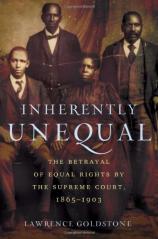Inherently Unequal: The Betrayal of Equal Rights by the Supreme Court, 1865-1903
Review
Inherently Unequal: The Betrayal of Equal Rights by the Supreme Court, 1865-1903
Much has been written about the erosion of civil rights during the Reconstruction and post-Reconstruction periods in America. Something happened after the war, beginning in the 19th century, that would turn the 20th into a bloody, repetitious nightmare for the vast majority of African American citizens. First they were granted full personhood under the law, emancipated and granted the right to vote; then, little by little, all of that bounty was snatched away, in great part through the machinations of the highest court of the land. It was a slow genocide of civil rights that then had to be resuscitated by dramatic triage beginning in the 1960s.
This book by Lawrence Goldstone, author of DARK BARGAIN: Slavery, Profits, and the Struggle for the Constitution, deftly and minutely details the process by which blacks, having gained so much on paper after the Civil War, lost it all to the racial bias of the members of the Supreme Court.
Much of the basis for cutting back the newly awarded rights of colored people at the time centered on the issue of states’ rights. An example is the composition of juries. If states were forced to place people of color on juries, it would abrogate their right to set the standard for who could serve. If states and locales set the standard in the South, they would obviously set the standard to include only property owners, literate persons, and persons who were otherwise on the rolls, which never included any non-whites. By locking in all-white juries, it was a near-certainty the blacks would not receive equal justice in the courts.
Consider two of the players on the Supreme Court after the death of Lincoln. Justice John Marshall Harlan, appointed by President Hayes, came from an antebellum slave-holding family, though they were considered “benign” slave-owners who opposed physical punishment of their “property.” Harlan would state that “our Constitution is color-blind, and neither knows nor tolerates classes among citizens. In respect of Civil Rights all citizens are equal under the law.” “But,” Goldstone tells us, “even Justice Harlan was not as color-blind as he claimed the Constitution to be.” Harlan also wrote, in the same opinion (Plessy v. Ferguson), “The white race deems itself to be the dominant race in this country. And so it is in prestige, in achievements, in education, in wealth and in power. So, I doubt not, it will continue to be for all time….” Harlan’s view was not considered blatant, racist or intolerant at the time.
Plessy v. Ferguson involved the right of a state to determine if railroad cars could be segregated “to maintain public order.” The Court ruled that the state could exercise such control, putting into play one of the many small but significant rulings that would come to be known as the Jim Crow laws. Another of the justices who spoke prominently in the Plessy decision was Henry Brown, a Yankee from an industrialist background, whose views on women, Jews, Native Americans and Asians were “every bit as ‘unenlightened’ as his opinion of African Americans.” In the Plessy case, Brown wrote: “If the two races are to meet upon terms of social equality, it must be the result of natural affinities, a mutual appreciation of each other’s merits, and a voluntary consent of individuals.” This often-cited “natural affinity” argument never addressed the fact that it was the blacks who were expected to change themselves to suit the needs and desires of the whites, never the other way around. African Americans would have to develop a “natural affinity” for a majority ill-disposed to accept them under any terms.
Not surprisingly, Jim Crow laws and lynchings caused large numbers of blacks to flee the South. This weakened those left behind and paved the way for more abuses of the law. The damage done by the white supremacy stance of the Supreme Court justices in the post-Reconstruction era has repercussions to the present day. Goldstone concludes that Plessy and other such cases brought before the Supreme Court are not merely “vestiges of an unenlightened time, but rather examples of a manner in which both to view and to apply the law that is very much with us today.”
Reviewed by Barbara Bamberger Scott on March 28, 2011
Inherently Unequal: The Betrayal of Equal Rights by the Supreme Court, 1865-1903
- Publication Date: January 18, 2011
- Genres: History, Nonfiction
- Hardcover: 256 pages
- Publisher: Walker & Company
- ISBN-10: 0802717926
- ISBN-13: 9780802717924





